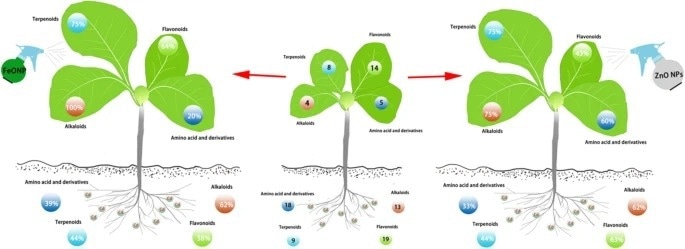Engineered nanomaterials (EMs) have physiochemical properties, applications, and concentrations that either negatively or favorably influence plant growth and development. Earlier research has demonstrated that the size and dosage of ferroferric oxide (Fe3O4) nanoparticles have an impact on tobacco (Nicotiana tabacum) seed germination. However, the tobacco response to heavy metals via EMs has received little attention.
 Fe3O4 and ZnO nanoparticles alleviate cadmium toxicity in tobacco. Image Credit: Jinpeng Wan.
Fe3O4 and ZnO nanoparticles alleviate cadmium toxicity in tobacco. Image Credit: Jinpeng Wan.
Investigators from Shanxi Agricultural University and the Chinese Academy of Sciences’ Xishuangbanna Tropical Botanical Garden (XTBG) examined the mechanisms underlying cadmium (Cd) tolerance in plants in a study that was published in the journal of nanobiotechnology.
The scientists examined the impact of Fe3O4 or zinc oxide nanoparticles (ZnO NPs) on plant growth and Cd responses in tobacco seedlings using the cultivar “Yunyan 87” (N. tabacum).
They started by analyzing the impacts of Cd on the growth of tobacco seedlings and discovered that exposure to Cd significantly inhibited plant height, shoot fresh weight, root length, and fresh weight growth.
The researchers also exposed tobacco seedlings to foliar exposure to Fe3O4, ZnO NPs, and ion solutions to determine whether Fe3O4 and ZnO NPs were involved in mediating the Cd response. Foliar application of Fe3O4 or ZnO NPs demonstrated significant promise in reducing plant growth under Cd stress.
Fe3O4, ZnO NPs, and ions substantially enhanced root growth and fresh weight compared to Cd-treated seedlings alone. Alkaloids, amino acids, and flavonoids were among the key metabolic pathways that Fe3O4 or ZnO NPs reprogrammed, and the differentially accumulated metabolites involved in these pathways were highly correlated with plant growth.
Our results collectively indicate that metal nanoparticles can serve as plant growth regulators and provide insights into using them for improving crops in heavy metal-contaminated areas.”
Jinpeng Wan, Xishuangbanna Tropical Botanical Garden, Chinese Academy of Sciences
Source:
Journal reference:
Zou, C., et al. (2022) Comparative physiological and metabolomic analyses reveal that Fe3O4 and ZnO nanoparticles alleviate Cd toxicity in tobacco. Journal of Nanobiotechnology. doi.org/10.1186/s12951-022-01509-3.